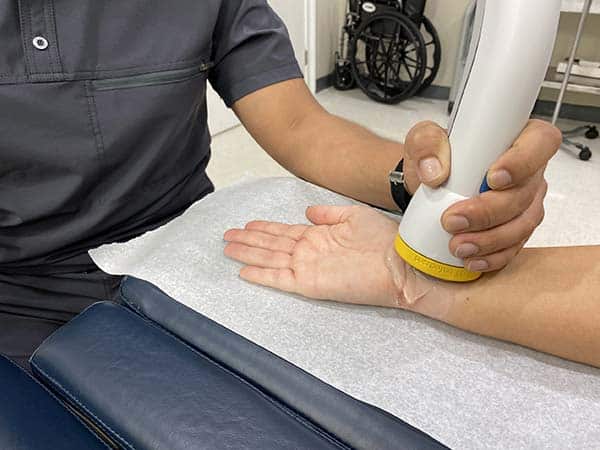

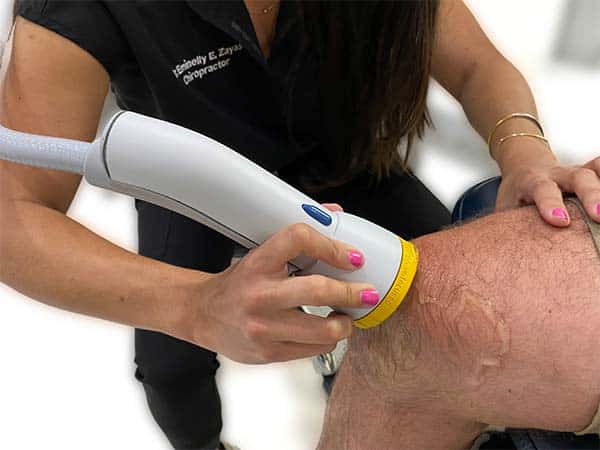
From serious sports injuries causing tissue damage to bone issues and stiffness that comes with age, living with pain is, well, a pain. But it's more than that - it's a stressful, often upsetting way to get through your day, month, and year. Have you ever tried to get out of bed with sore, stiff knees? Most folks would rather just get back in bed. Think you might try exercising with plantar fasciitis? Don't plan on running far or doing cardio for very long. Torn rotator cuff? Without proper treatment, your life might not ever be the same.
Living with pain and the inevitable issues that come with age can seriously affect your wellbeing and happiness. Sure, you could wake up every morning and rely on addicting medications to help you move. Or, you could risk further injury and damage with invasive surgeries that require long periods of recovery and downtime. But those can't be the only two options for treatment, can they?
Fortunately, a new, natural, non-invasive treatment for pain is revolutionizing the medical industry and transforming people's lives. It's giving athletes, average folks, and people of a certain age a reason to be hopeful. It's called Softwave therapy, and unlike many fly-by-night medications and sketchy treatments, it's backed by science and provided by Elite Healthcare Physical Medicine.
If you're barely making it through the day suffering from chronic pain, this FDA-approved drug-free treatment may be for you. Softwave therapy has already been used by thousands of people around the country living with issues like shoulder pain, knee pain, and plantar fasciitis. You could be next.
Though its popularity has only grown in recent years, Softwave therapy - also known as shockwave therapy - has been around for years. In fact, the first systematic study into the benefits of shockwave therapy took place way back in 1950. So, what is Softwave therapy?
Softwave therapy is a method of treatment that works incredibly well for mobility rehab, pain relief, and full-body recovery, usually from chronic pain or injuries. Softwave therapy uses a device emitting low-energy soundwaves that target a patient's injured area. These low-intensity waves boost blood flow and kickstart your body's natural healing processes, relieving long-term pain and helping your body to heal a wide range of injuries and conditions.
The main targets in the body include bones, tendons, and other soft tissues, which are encouraged to regenerate and repair via the shockwaves. Often, shockwave therapy is used in conjunction with other non-invasive treatments like chiropractic care, which we offer at Elite Healthcare Physical Medicine. The results are often incredible, leaving patients wondering why they never tried Softwave therapy before.
Softwave therapy works especially well for:

Better Blood Flow

Collagen Stimulation

Reducing Inflammation

Kickstarting cell growth and healing factors

Breaking down build-ups of calcium
With FDA clearance, little-to-no side effects, and quick application time, Softwave therapy is a welcome alternative for people suffering from pain. Who wants to spend weeks or months recovering from a surgery that might not even work? Likewise, who would want to become dependent on over-the-counter or, even worse, prescription pain meds? Living a life of addiction is a road nobody wants to go down.
Softwave therapy represents a revolution in non-invasive pain treatment; best of all, it's highly effective. Independent studies prove that shockwave therapy helps with pain. 65-91% of patients using shockwave therapy experienced real-deal improvements in damaged muscle and bone tissue, solving their mobility problems and drastically reducing pain. It almost sounds too good to be true, but as many patients at Elite Healthcare Physical Medicine will tell you - it isn't.
Book AppointmentSome of the most common conditions that Softwave therapy treats include:









When you get up in the morning and go to the bathroom to brush your teeth, do you notice a stabbing, sharp pain near your heel? Does the pain go away once you have a chance to walk around? If so, you could have plantar fasciitis. According to the American College of Foot and Ankle Surgeons, this painful condition is quite common. About two million people suffer from plantar fasciitis every year, and almost 10% of all people will experience the condition at least once in their life.
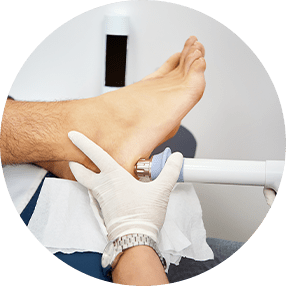
This common foot issue happens when the plantar fascia - a fan-shaped tissue near your heel - gets inflamed. The plantar fascia is a thick strip of connective tissue that links your toes to your heel bone, helping to preserve the arch of your foot. When this band is strained, it causes intensely sharp pain, usually in the morning when you wake up and plant your feet on the floor.
Most folks ignore plantar fasciitis because the pain eventually goes away throughout the day. However, if left untreated, plantar fasciitis can lead to weakness and chronic pain, which may affect daily walking.
Some causes of plantar fasciitis include:
The short answer to this question is not really. Patients with plantar fasciitis will ice the affected area with little-to-no relief since they spend so much time on their feet. It's hard to rest an achy heel if you've got a job that requires you to be on your feet. Anti-inflammatory meds like Advil don't work all that well, either. They may provide temporary pain relief, but in terms of a long-term solution, taking these drugs will cause major side effects.
Book AppointmentWhen more conservative treatment options like ice and over-the-counter meds don't work, most doctors turn to ultra-expensive orthotics, steroid injections, or invasive surgery. For the average person, those options fail on all fronts, as they carry risks for side effects and may even cause the issue to worsen.
Instead of going under the knife or changing their daily routines, many people suffering from plantar fasciitis are turning to Softwave therapy for relief.
During a shockwave therapy session, our expert providers use a special probe to deliver pressure waves to inflamed tissue. These waves trigger natural healing processes causing new blood vessels to form. In turn, oxygen is supplied to the affected area, reducing inflammation and causing healthy cells to regenerate. Shockwave therapy also produces collagen, which is crucial for connective tissue health.
With just a few visits, many patients find long-term relief from plantar fasciitis without relying on strange drugs or harmful surgeries.
Living with knee pain is just miserable. From knee tendonitis to osteoarthritis, knee pain can prevent you from enjoying activities and affect your day-to-day life. Your knee is a joint comprised of cartilage, bone, ligaments, and fluids. Tendons and muscles within the knee help the joint move. When one of these crucial knee structures is hurt or compromised, it results in knee pain and long-lasting knee problems. This, in turn, leads to difficulty walking at best and debilitating knee issues at worse.
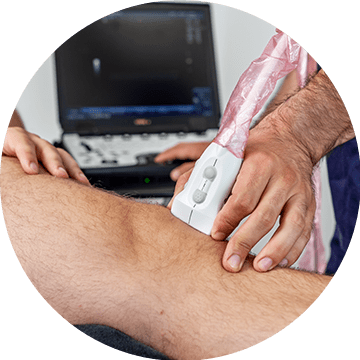

If you're an active person or somebody who plays sports often, you're probably all too familiar with knee pain - especially common conditions like patellar tendinopathy. Also called "jumpers knee," this issue happens at the patellar tendon, which is found on the front of the knee just under the knee cap. When living with this condition, most patients experience pain around the kneecap or lower down on the leg around the tibia.
In addition to injuries and issues like jumper's knee, everyday wear and tear will cause knee pain over time. With time, this knee pain can develop into arthritis. If your knees are swollen, painful, or stiff, you may have arthritis in your knees. Regardless of the kind of knee pain you're experiencing, treatment options have been limited to agonizing surgeries and addicting pain medications. But that all changes with shockwave therapy for knee pain in Sullivan's Island, SC.

Though no two knee pain problems are exactly the same, shockwave therapy has been shown to be highly effective for knee pain. In fact, many patients at Elite Healthcare Physical Medicine find relief after just one session. Many times, sessions can be completed in as little as 30 minutes. So if you want to find relief for knee pain on your lunch break, that's definitely possible.
As is the case with plantar fasciitis, Softwave therapy works by sending sound wave and low-energy impulses to the affected area of your knee. These pulses stimulate your body's healing factors, which can help regenerate and repair damaged tendons and tissues. Softwave therapy for knee pain is especially promising for people who have tried other treatments - like surgery and pain meds - with disappointing results.
Benefits include:
Several studies and reviews prove that Softwave therapy can be very beneficial for people suffering from knee pain problems like jumper's knee. A study involving 66 patients with knee pain found that they enjoyed a significant improvement in their reported pain levels with Softwave therapy. In fact, knee pain was reduced by nearly 50% after a single month. When combined with other regenerative and physical therapy treatments at Elite Healthcare Physical Medicine, your days of living with knee pain are numbered.
Book AppointmentHere's a fact for you to consider: Every joint that you have in your body plays a part in your day-to-day life. But when we think of joint issues, we typically jump to knee issues. However, your knees aren't the only joints in your body to go through wear and tear. Your shoulders experience just as much, if not more, wear and tear than your knees. We put a strain on our shoulders just about every time we use or move our arms. Our shoulders play a pivotal part in living a normal life. When they begin to deteriorate over time due to age or overuse, it creates a litany of painful problems.
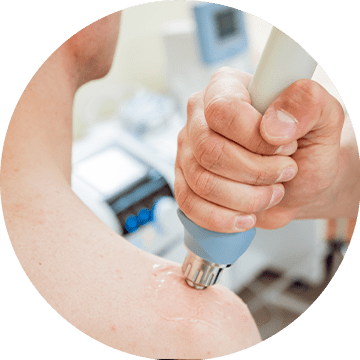

There are many causes of shoulder pain, like deterioration, inflammation, and trauma. Of the many painful shoulder conditions affecting Americans yearly, rotator cuff tendonitis and arthritis are very common. Also called calcific tendinitis, rotator cuff pain is caused by built-up calcium deposits on the shoulder's tendons, which connect your rotator cuff to nearby muscles and bones. This painful condition is usually linked to sports, like basketball and volleyball, or in professions requiring repetitive movements, like in the plumbing industry.
Some common symptoms of shoulder pain and rotator cuff tendinitis include:
Though strengthening exercises and some medications provide temporary relief for shoulder pain, they're not meant as long-term solutions. Luckily, Softwave therapy for rotator cuff pain in Sullivan's Island, SC, can help.
Shockwave therapy has been shown to work wonders for shoulder pain. Low-intensity shockwaves break up calcium deposits and jumpstart your body's healing processes, stimulating blood flow and healthy cell growth. Shockwave treatment is especially effective for long-term shoulder pain since it releases stem cells, sends growth factors to the affected area, and boosts capillary production. Shockwave therapy has also been shown to break down scar tissue and eliminate trigger points, all of which decrease shoulder pain. This relief is most often long-lasting, unlike other treatments like medications and injections.
Many studies support the efficacy of Softwave therapy for shoulder conditions like rotator cuff pain and calcific tendonitis of the shoulder. In a study of 84 patients living with long-term rotator cuff tendonitis, participants in the treatment group saw a significant decrease in the intensity of their shoulder pain. Another study related to shockwave therapy for calcific tendonitis found that 86.6% of patients experienced fewer calcifications.
If you're having to live with rotator cuff pain or another type of shoulder issue, choosing Softwave therapy may be your best course of action.
Book AppointmentWhether you're sick of living with intense heel pain from plantar fasciitis, the mobility issues associated with knee pain, or the day-to-day struggles of rotator cuff degeneration, you'll find hope at Elite Healthcare Physical Medicine. Unlike some medical clinics, our team of doctors and specialists focus on an integrative, multidisciplinary approach to healing. Instead of relying on addictive medications and invasive surgeries, we prefer to address the underlying causes that our patients face.
We combine several all-natural pain relief therapies so that your shoulder pain, knee pain, joint pain, and foot pain go away for good. We resolve pain by using healing treatments that restore function and improve mobility for the long term. Our state-of-the-art regenerative medicine treatments, used hand-in-hand with proven chiropractic techniques, will stimulate your body's healing power from within. If your pain is related to muscles, nerves, and bones, our doctors can help you overcome discomfort, injury, or medical conditions affecting these systems.
If you've been unable to resolve your pain or have become dependent on painkillers to cope, Softwave therapy may be the natural solution you need. It all starts with a quick call to our office, so we can begin to understand your needs. When you come for your first visit, our doctors will find the personalized treatment you need so that you can manage your pain in a non-invasive and drug-free environment manner.
Book AppointmentThe water utility is threatening to shut off the tap for Sullivan’s Island when the town's contract expires July 20, alleging that the town owes more than $1 million in back charges.CWS CEO Mark Cline told The Post and Courier that Sullivan’s Island has been paying an “arbitrary and unsupported” volumetric rate for their water — 88 cents per thousand gallons of water — since 2017.This rate was not issued by the utility, Cline said. Mike Saia, a spokesman for CWS, said the rate the utility iss...
The water utility is threatening to shut off the tap for Sullivan’s Island when the town's contract expires July 20, alleging that the town owes more than $1 million in back charges.
CWS CEO Mark Cline told The Post and Courier that Sullivan’s Island has been paying an “arbitrary and unsupported” volumetric rate for their water — 88 cents per thousand gallons of water — since 2017.
This rate was not issued by the utility, Cline said. Mike Saia, a spokesman for CWS, said the rate the utility issued for Sullivan's Island in 2017 was 96 cents per thousand gallons of water.
In an October 2023 letter to Sullivan’s Island Mayor Pat O’Neil, Cline warned the town that unless charges were paid and a new contract was agreed upon by July 20, the utility would shut off the three water supply connections that serve the town.
Sullivan’s Island has had a wholesale contract with CWS since 1994. The town has up to 750,000 gallons of water available per day.
Other nearby communities, like Isle of Palms, purchase water from CWS.
Chris Jordan, general manager for the island’s water and sewer commission, said the commission pays roughly $1.23 per thousand gallons of water used. Last year, the city paid around $100,000 in capital charges.
The city’s contract, initiated in 1995, allows for up to 1.5 million gallons of water per day. Jordan said the commission intends to renew its contract with Charleston Water System when the time comes.
CWS calculates the volumetric rate for its wholesale customers on an annual basis. The rate can fluctuate from year to year, Cline said, based on economic factors and the cost of service. The utility also issues capital charges annually to fund infrastructure upkeep and other projects.
Sullivan’s Island paid both of these charges in full for 23 years. Things changed in 2017.
That year, the town stopped paying capital charges and began paying 88 cents per thousand gallons of water, a fraction of the rate issued by the utility, Cline said.
Cline also alleged that Sullivan’s Island has been charging its residents the full rate set by the utility but not paying the full rate to CWS.
The town has amassed roughly $1,007,300 in back charges as of December 2023, Cline said.
If this debt is not paid and a new agreement is not reached, the roughly 2,000 residents that call Sullivan’s Island home will lose access to water — including drinking water.
According to the town's February water report, CWS and Sullivan's Island began mediation on Feb. 7 to resolve the dispute.
O’Neil, the mayor, and Town Administrator Andy Benke declined to comment on the dispute or how much they are charging their residents.
Sullivan's Island Water and Sewer Manager Greg Gress also declined to comment on the dispute.
“The Town is involved in mediation with CWS, and in that regard bound by the confidentiality agreement of that process,” Benke said.
Cline said the utility has delivered at least seven letters to Sullivan’s Island since 2019, calling for resolution of the dispute and a new contract.
"We have been continuously communicating with the Town of Sullivan's Island about this issue for five years, predominantly in letter form. They've been aware of this issue for some time," Cline said.
In 2019, the town and CWS signed a conditional memorandum that said a rate formula must be agreed upon by April 2, 2019.
But because CWS would not exclude capital charges from its rate formula, town officials did not approve the memorandum, O'Neil wrote in a September 2023 letter to the utility.
SULLIVAN’S ISLAND, S.C. (WCSC) - A yearslong dispute between Sullivan’s Island and the Charleston Water System could leave thousands of residents without water starting in July if over $600,000 in debt is not paid.As of Sept. 28, 2021, Charleston Water System claims Sullivan’s Island owes them $197,468 in billed, but unpaid, volumetric charges and $442,478 in billed but unpaid capital charges.Charleston Water says the town changed how much they paid per 1,000 gallons in 2017, even after paying the same amount ...
SULLIVAN’S ISLAND, S.C. (WCSC) - A yearslong dispute between Sullivan’s Island and the Charleston Water System could leave thousands of residents without water starting in July if over $600,000 in debt is not paid.
As of Sept. 28, 2021, Charleston Water System claims Sullivan’s Island owes them $197,468 in billed, but unpaid, volumetric charges and $442,478 in billed but unpaid capital charges.
Charleston Water says the town changed how much they paid per 1,000 gallons in 2017, even after paying the same amount since the contract began in 1994.
They say that the paid charge went from $1.22 per 1,000 gallons to 88 cents per 1,000 gallons.
Charleston Water wrote in a January 2019 letter that “after more than 20 years, the town of Sullivan’s Island does not believe the contract requires them to pay any portion of Charleston Water’s capital expenses, a belief which has no support whatsoever of our board of commissioners or legal counsel.”
After getting a rate consultant, Charleston Water offered Sullivan’s to pay 89 cents per 1000 gallons. According to numerous letters, the island refused.
An opinion from the state Attorney General in 2019, states Sullivan’s Island does not have the authority to interpret contracts, but believes both of these parties must finish their initial term of 30 years and then they are able to terminate it if everyone is notified.
Sullivan’s Island says they disagree with this opinion and there are four unresolved topics between the two: capital charges, fire hydrants, the municipal wholesale rate as an excess demand charge and the rate formula.
Charleston Water says Sullivan’s Island has two choices: to pay all outstanding balances and they can continue to purchase water at the then-published municipal whole rate or find an alternate water source starting July 20 of this year.
In a 2021 resolution from Charleston Water, they say they discovered through this lack of payment that 18 fire hydrants were not being paid for on the island. If they’re not paid, all will be removed except for those used for water main flushing.
Starting this month, they will send out delinquent notices to DHEC, the State Fire Marshal, Sullivan’s Island residents and other state agencies on a monthly basis that the water will be shut off starting July 20 – when the 30-year contract is up – if this procedures are not followed.
In response to these letters, Andy Benke, the town administrator for Sullivan’s Island, provided this statement:
It’s disappointing that the leadership at Charleston Water System has apparently decided to ignore the confidentiality agreement put in place during the mediation of our long-standing dispute.
Years ago, CWS decided to raise our rates as if our signed contract with them did not exist.
As CWS knows, we’ve simply been continuing to pay the undisputed amount set in our long-standing, signed agreement.
We hope everyone will understand we’re standing firm on the principle that signed contracts are signed contracts. It’s the right thing to do for our citizens.
We will continue our good faith efforts to reach an appropriate agreement through mediation, or if need be, in the court.
Charleston Water claims Sullivan’s Island revised its interpretation of the 1994 agreement in 2016 and part of the dispute is whether the island should have to pay any portion of CWS’s capital expenses.
Charleston Water System says they can’t make any further comment because it’s still in legal mediation.
You can read more about the dispute below, or click here.
Attachment to 06-21-23 Contract Dispute by Live 5 News on Scribd
Copyright 2024 WCSC. All rights reserved.
SULLIVAN’S ISLAND, S.C. (WCBD) — The town of Sullivan’s Island could have its water supply cut off this summer, amid a dispute with the Charleston Water System.According to a letter sent to the town from Charleston Water System (CWS) in October 2023, when Sullivan’s Island purchased 750,000 gallons per day of capacity from the Charleston Water System in 1994, it was a 30-year term which expires on July 19, 2024.The water system tells Sullivan’s Island leaders that if there is not a new contract by ...
SULLIVAN’S ISLAND, S.C. (WCBD) — The town of Sullivan’s Island could have its water supply cut off this summer, amid a dispute with the Charleston Water System.
According to a letter sent to the town from Charleston Water System (CWS) in October 2023, when Sullivan’s Island purchased 750,000 gallons per day of capacity from the Charleston Water System in 1994, it was a 30-year term which expires on July 19, 2024.
The water system tells Sullivan’s Island leaders that if there is not a new contract by then, service will be disconnected for the town’s 2,000 residents on July 20.
In addition, in the letter, the water system said the town has been paying $0.88 per thousand gallons of water since 2017, and calls that rate “arbitrary and unsupported by facts.”
Charleston Water System says the rate in 2017 was $0.96, and each year, there is a new projected rate for the town. For example, the rate last year was $1.53 per thousand gallons. At the end of the year, an adjusted rate was given which amounted to $1.11.
CWS also said in the letter to Sullivan’s Island that they are willing to provide water service to the town as long as it pays all outstanding amounts owed to the water system. As of February, that amount totaled $1.08 million.
In previous letters responding to Charleston Water System, Sullivan’s Island Mayor, Patrick O’Neil, said they have been paying the correct rate and that a memorandum of understanding on a rate formula was never approved.
“SI (Sullivan’s Island) has been paying the undisputed portion of the volumetric rate since 2017. SI does not owe capital charges unless SI purchases additional capacity which SI has not done.” a letter dated June 30 to CWS reads.
Sullivan’s Island leaders claim that the contract with the water system is clear that capital charges should not be charged on top of the initial capacity the town purchased in 1994. The town also adds that “because SI has not given written notice to CWS not to renew the contract, the contract will be automatically renewed for 15 years or until July 19, 2039, as set forth in the contract.”
In its October letter responding to the town, CWS CEO, Mark Cline, said CWS cannot agree to a rate formula that does not include capital charges or a perpetual term.
As of now, Sullivan’s Island and Charleston Water System are in legal remediation for the issue.
On Friday, Sullivan’s Island leaders released a statement to News 2:
“It’s disappointing that the leadership at Charleston Water System has apparently decided to ignore the confidentiality agreement put in place during the mediation of our long-standing dispute.
Years ago, CWS decided to raise our rates as if our signed contract with them did not exist.
As CWS knows, we’ve simply been continuing to pay the undisputed amount set in our long-standing, signed agreement.
We hope everyone will understand we’re standing firm on the principle that signed contracts are signed contracts. It’s the right thing to do for our citizens.
We will continue our good faith efforts to reach an appropriate agreement through mediation, or if need be, in the court.”
– Sullivan’s Island town leaders
SULLIVAN’S ISLAND, S.C. (WCSC) - The mayor of Sullivan’s Island fired the latest salvo Wednesday afternoon in a battle over how much the town owes the Charleston Water System for service as it faces a July deadline.Mayor Patrick O’Neal released the following statement Wednesday in response to the water utility’s blasting of a proposal that would have the town pay a fraction of what Charleston Water System says is the balance due:Charleston Water System wants the town to ignore the terms of the signed ...
SULLIVAN’S ISLAND, S.C. (WCSC) - The mayor of Sullivan’s Island fired the latest salvo Wednesday afternoon in a battle over how much the town owes the Charleston Water System for service as it faces a July deadline.
Mayor Patrick O’Neal released the following statement Wednesday in response to the water utility’s blasting of a proposal that would have the town pay a fraction of what Charleston Water System says is the balance due:
Charleston Water System wants the town to ignore the terms of the signed agreement we entered into almost 30 years ago, after Hurricane Hugo devastated our independent deep water well system. We entered into that agreement at a significant cost to ensure that our residents would have certainty as to the source of our water for decades to come. It’s hard now to accept the baseless claim that CWS (or anyone else) is “subsidizing” Sullivan’s Island when we paid almost $2 million — in 1994 dollars — to support the infrastructure that allowed them to sell water to us and to our neighbors on the Isle of Palms, and when in 2020 we gifted them an easement through our public park and playground so there would be additional capacity to sell water to our neighbors in Mount Pleasant.
The Charleston Water System on Tuesday responded to a motion passed during Monday night’s town council meeting that proposed the paying of $227,361 to “satisfy in full” the disputed debt. Charleston Water System CEO Mark Cline said the utility “does not agree” with the town’s viewpoint “or its recollection of historical facts.”
“We fully intend to discontinue the town’s water service July 20 unless their past due amount is fully paid and they have entered into a new contract that appropriately covers the costs of providing water service to their community,” Cline said. “It’s not fair that our other customers have been subsidizing the Town’s service for years now, and that would continue under their terms.”
The utility claims the town owes a total of more than $639,000. That figure includes $197,468 in billed but unpaid volumetric charges and $442,478 in bill but unpaid capital charges.
Copyright 2024 WCSC. All rights reserved.
CHARLESTON COUNTY, S.C. (WCSC) - Leaders say the search is over in the hunt for a new town administrator for Sullivan’s Island after months of recruitment efforts.Current Town Administrator Andy Benke says Joseph R. “Joe” Henderson will be the newest town administrator come June.Benke first announced plans to retire in Oct. of last year after over two decades of service as town administrator for Sullivan’s Island. His announcement kicked off what officials called an extensive search for a replacement, wh...
CHARLESTON COUNTY, S.C. (WCSC) - Leaders say the search is over in the hunt for a new town administrator for Sullivan’s Island after months of recruitment efforts.
Current Town Administrator Andy Benke says Joseph R. “Joe” Henderson will be the newest town administrator come June.
Benke first announced plans to retire in Oct. of last year after over two decades of service as town administrator for Sullivan’s Island. His announcement kicked off what officials called an extensive search for a replacement, which they say involved the vetting of 28 candidates.
The Town Council unanimously approved Henderson’s appointment to the position.
Henderson served as the director of planning and zoning for Sullivan’s Island from 2013 until 2022, when he was promoted to be the town’s deputy administrator.
Aside from experience, Henderson qualifies for the job with a number of degrees obtained from a series of South Carolina colleges and universities. He holds a Bachelor of Arts in political science from Coastal Carolina University, a Graduate Certification in urban planning from the College of Charleston and a Master of public administration from Clemson University.
He also has professional certifications include floodplain management, arboriculture and zone inspection. Before moving to Sullivan’s Island, Henderson working as the zoning administrator and the interim planning director for the city of Conway.
Sullivan’s Island Mayor Patrick O’Neil expressed gratitude for Benke’s 21 years of service before expressing his faith in Henderson.
“We were privileged to have Andy Benke serve as the Administrator since 2003 and wish him well in retirement. His efforts helped keep Sullivan’s Island a desired place to live and visit,” O’Neil said. “As Andy’s Deputy Administrator, Joe Henderson is well suited to succeed him. I am confident that the great work we have started over the past years will continue with Joe.”
Henderson himself expressed his gratefulness to the Town for picking him for the position.
“It’s an honor to continue to serve the community in the role of Town Administrator. We have exciting opportunities and challenges facing the Town in the coming years,” Henderson said. “I’m very fortunate to be supported by the Town Council and the employees who provide the public with exemplary service on all levels.”
Officials say Benke will continue to serve as town administrator until June 18 in order to guarantee a smooth transition.
Copyright 2024 WCSC. All rights reserved.
